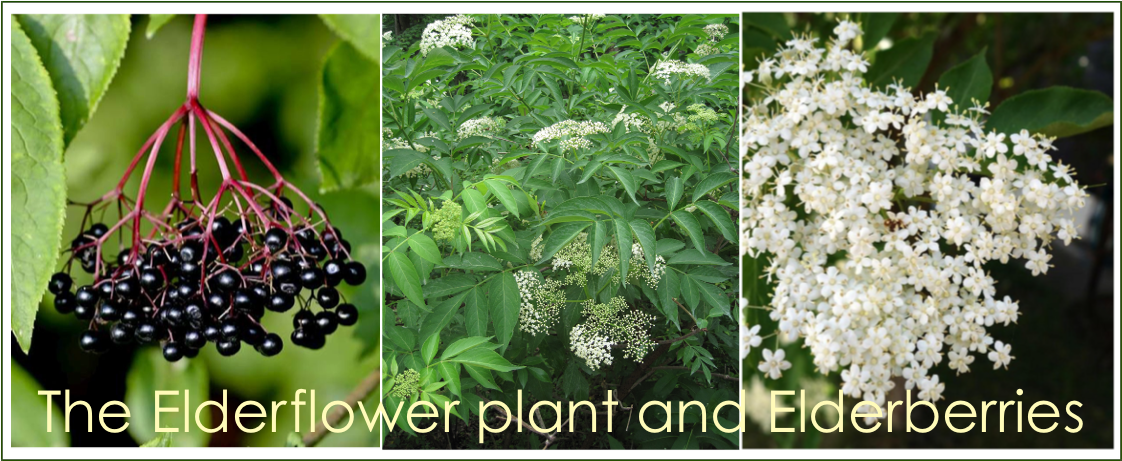Today’s post is about the Elderflower plant and Elderberries.
We have an elderflower bush in our garden and we know that parts of this plant are reported to be edible and have health benefits. However, we are not sure which parts, how to prepare them or the health benefits.
So, I decided to do the research to find out and, as usual, I am sharing what I found.
First, a bit about the plant
The Elderflower or Sambucus canadensis is a member of flowering plants in the Adoxaceae family. The various species are commonly referred to as elder, elderflower or elderberry. It is a deciduous shrub or small tree which grows from 3 to 4 metres high. It has lacy, umbrella-like sprays of pale flowers that bloom from spring to autumn. The fruit is a dark purple to black berry 3–5 mm in diameter, produced in drooping clusters in the late autumn.
Elders are often grown as a hedgerow plant in Britain since they take very fast, can be bent into shape easily, and grow quite profusely. For this reason, it has gained the reputation of being ‘an instant hedge’. It is not generally affected by soil type and will virtually grow anywhere sufficient sunlight is available. There are indigenous species that grow on the edge of rainforests in NSW and the Otway Ranges in Victoria and are considered important bush foods.
Many species are widely cultivated for their ornamental leaves, flowers, and fruit.
How can the plant be used?
Firstly, caution is advised when consuming this plant as the berries, bark, and leaves are actually, mildly toxic and must not be used in their raw state. Using heat destroys these toxins. Only eat elderberries after boiling them and removing all seeds with a sieve.
The aromatic flowers of the elder bush have been used in kitchens since Roman times and can be eaten raw or cooked. These flat-topped sprays of creamy white flowers have a distinctly musky and sweet fragrance. The young leaves, by contrast, smell pretty bad. Historically, bunches of the foliage were once tied to the harnesses of working horses to ward off flies.
Historically the elderflower has been used as a medicinal plant by many native peoples and herbalists alike. The traditional uses of elderflower plants involved the whole plant, with elderflower teas, tinctures made from the bark and the fruit used for many ailments.
These plant extracts are used to treat bronchitis, coughs, upper respiratory cold infections, fever.
The berries are edible after cooking and can be used to make jam, jelly and chutney sauce. Also, when cooked, are often used with blackberries and with apples in pies. The flower heads are commonly used in infusions, giving a very common refreshing drink.
Elderflowers are also used to make a cordial that is used as a mixer with gin, ice and soda. They are also used to make Elderflower kombucha, or even Elderflower champagne, a naturally bubbly, lightly alcoholic drink made in a similar way to ginger beer.
Do the berries or flowers have health benefits?
The berries have been found to have a high concentration of compounds such as flavonols, phenolic acids and anthocyanins, which are known for their antioxidant activity. They have greater potential health benefits than blueberries and cranberries. In addition, they are very low in calories and have a much higher content of Vitamins A, C and B6 than other berries. They are also high in dietary fibre.
Elderberry extract has been found to help reduce the length and severity of symptoms caused by the influenza virus. Studies have shown elderberry juice may reduce the level of fat in the blood and decrease cholesterol. In addition, a diet high in flavonoids like anthocyanins has been found to reduce the risk of heart disease.
So, the takeaway from this research is that elderberry has been associated with many promising health benefits. When prepared properly, elderberry is a flavourful addition to a healthy diet and a good source of vitamin C, fibre, and antioxidants.
It may also be fun to make some Elderflower Champagne.
Till the next post,
Live clean n Prosper
Sources – Wikipedia – Renaissance Herbs – The Mudbrick Herb Cottage – Jamie Oliver – Healthline –

